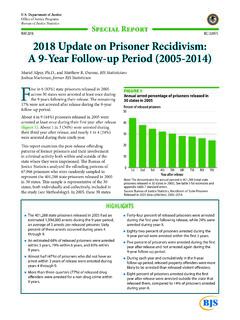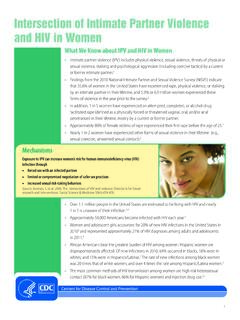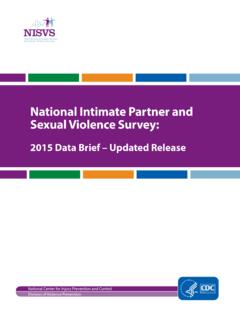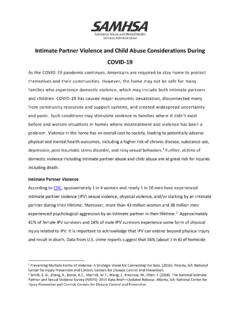Transcription of Bureau of Justice Statistics Selected Findings
1 Department of JusticeOffice of Justice ProgramsBureau of Justice StatisticsSelected FindingsSeptember 2009, NCJ 228356 Shannan Catalano, , Erica Smith,Howard Snyder, , and Michael RandBJS StatisticiansThis report provides the current Findings on nonfatal and fatal violent crimes committed against females. Data are from the Bureau of Justice Statistics National Crime Victim-ization Survey (NCVS), 1993 to 2008, and the Federal Bureau of Investigation s (FBI) Uniform Crime Reporting Program's (UCR) Supplementary Homicide Reports (SHR), 1993 to 2007 (the most recent data available). The report focuses on nonfatal intimate partner violence (IPV), fatal IPV, rape and sexual assault, and stalking. It includes esti-mates of the extent of crimes against females and the characteristics of crimes and vic-tims.
2 Crime trends are also presented, along with comparative estimates of crimes against intimate partner violence intimate partner violence includes victimization committed by spouses or ex-spouses, boyfriends or girlfriends, and ex-boyfriends or ex-girlfriends. In 2008 females age 12 or older experienced about 552,000 nonfatal violent victim-izations (rape/sexual assault, robbery, or aggravated or simple assault) by an inti-mate partner (a current or former spouse, boyfriend or girlfriend) (table 1). In the same year, men experienced 101,000 nonfatal violent victimizations by an inti-mate partner . The rate of intimate partner victimizations for females was victimizations per 1,000 females age 12 or older. The equivalent rate of intimate partner violence against males was victimizations per 1,000 males age 12 or Victims of ViolenceTable 1.
3 violence by intimate partners, by type of crime and gender of the victims, 2008 TotalFemaleMaleNumberRateNumberRateNumbe rRateOverall violent crime652, , , assault44, , ^8, ^Robbery38, ^38, ^----Aggravated assault111, , , ^Simple assault458, , , : Victimization rates are per 1,000 persons age 12 or older. The difference in male and female intimate partner victimization rates is significant at the 95% confidence level for overall violent crime, robbery, and simple assault. There is no significant difference in the rate of male and female intimate partner victimization for aggravated assault.^Based on 10 or fewer sample cases. --No cases were present for this : Bureau of Justice Statistics , National Crime Victimization Survey, 10/23/092 Female Victims of violence Females age 18 or older experienced higher rates of intimate partner violence than females age 12 to 17 ( per 1,000 compared to per 1,000, respectively).
4 Black females historically have experienced intimate partner violence at rates higher than white females. In 2008, Hispanic and non-Hispanic females experienced intimate partner violence at about the same rates ( per 1,000 females age 12 or older versus per 1,000, respectively). In 2008, 72% of the intimate partner violence against males and 49% of the intimate partner violence against females was reported to police. About 99% of the intimate partner violence against females in 2008 was committed by male offenders. About 83% of the intimate partner violence against males was commit-ted by female offenders in in nonfatal intimate partner violence intimate partner violence against both males and females declined at a similar rate between 1993 and 2008 (figure 1).
5 The rate of intimate partner violence against females declined 53% between 1993 and 2008, from victimizations per 1,000 females age 12 or older to per 1,000. Against males, the rate declined 54%, from victimizations per 1,000 males age 12 or older to per 1, intimate partner violence Fatal intimate partner violence includes homicide or murder and non-negligent man-slaughter, defined as the willful killing of one human being by another. In 2007 intimate partners committed 14% of all homicides in the The total esti-mated number of intimate partner homicide victims in 2007 was 2,340, including 1,640 females and 700 males.**Homicide data are voluntarily reported to the FBI by law enforcement agencies active in the Uniform Crime Reporting Program.
6 Offender information (and, therefore, information on the victim-offender relationship) is missing in about 1 in every 3 murders reported. This information is missing because either no offender was iden-tified or information on the identified offender was not sent to the FBI. For this report, missing victim-offender relationships were estimated by assuming that the distribution of relationships in murders for which the relation-ship was known was the same as in murders for which the relationship information was violent victimization rate by victim/offender relationship and victim gender, 1993-2008 Figure 1199319961999200220052008010203040 StrangerFriend/acquaintanceIntimateOther relativeFemale victimsRate per 1,000 females age 12 or older199319961999200220052008010203040 StrangerFriend/acquaintanceOther relativeIntimateMale victimsRate per 1,000 males age 12 or olderSource.
7 Bureau of Justice Statistics , National Crime Victimization Survey, 10/23/09 Female Victims of Violence3 Females made up 70% of victims killed by an intimate partner in 2007, a proportion that has changed very little since 1993. Females were killed by intimate partners at twice the rate of males. In 2007 the rate of intimate partner homicide for females was per 100,000 female residents com-pared to per 100,000 male residents. Females are generally murdered by people they know. In 64% of female homicide cases in 2007, females were killed by a family member or intimate partner . In 2007, 24% of female homicide victims were killed by a spouse or ex-spouse; 21% were killed by a boyfriend or girlfriend; and 19% by another family member.
8 In an additional 25% of cases in 2007, females were killed by others they knew. An estimated 10% of female murder victims were killed by a stranger. In 2007 black female victims of intimate partner homicide were twice as likely as white female homicide victims to be killed by a spouse ( and per 100,000, respec-tively). Black females were four times more likely than white females to be murdered by a boy-friend or girlfriend ( and per 100,000, respectively). Men were more likely than women to be killed by strangers. Among male homicide vic-tims in 2007, 16% were murdered by a family member or intimate partner . Of male homicide victims, 2% were killed by a spouse or ex-spouse and 3% were killed by a girlfriend or boyfriend.
9 Over half (54%) were killed by others they knew, and 29% were killed by strangers. Trends in fatal intimate partner violence Between 1993 and 2007 the total number of homicide victims in the fell 31%, with a somewhat greater decline for females (-34%) than males (-30%). Homicide victims killed by intimate partners fell 29%, with a greater decline for males (-36%) than females (-26%) (figure 2).Homicides of intimate partners by gender of victim, 1993-2007 Figure 21993 1995 1997 1999 2001 2003 2005 200705001,0001,5002,0002,5003,000 FemaleMaleSource: Bureau of Justice Statistics ' analysis of the Federal Bureau ofInvestigation's Uniform Crime Reporting Program's Supplementary HomicideReports, of victimsNote: Homicide data are voluntarily reported to the FBI by law enforcementagencies active in the Uniform Crime Reporting Program.
10 Offender information (and,therefore, information on the victim-offender relationship) is missing in about 1 inevery 3 murders reported. This information is missing because either no offenderwas identified or information on the identified offender was not sent to the FBI. Forthis report, missing victim-offender relationships were estimated by assuming thatthe distribution of relationships in murders for which the relationship was knownwas the same as in murders for which the relationship information was 10/23/094 Female Victims of violence Homicide victims killed by an intimate partner declined from an estimated 3,300 in 1993 to an estimated 2,340 in 2007. Between 1993 and 2007, female victims killed by an intimate partner declined from 2,200 to 1,640 victims, and male intimate partner homicide victims declined from 1,100 to 700 victims.


















